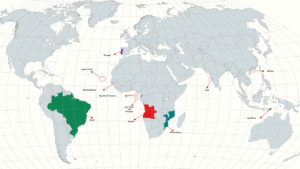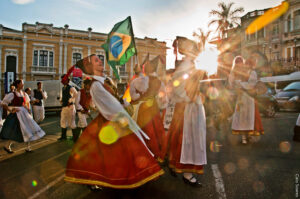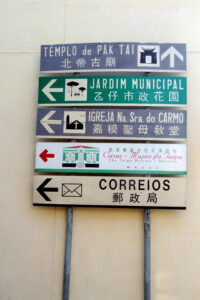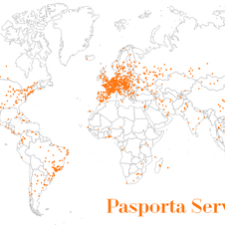The 5th of May: World Portuguese Language Day… What are we celebrating?
On the 5th of May, we commemorate World Portuguese Language Day, but what exactly is the significance of this celebration? In 2019, UNESCO designated May 5th as World Portuguese Language Day, a date initially established by the Community of Portuguese Language Countries (CPLP) in 2009. Portuguese – a language spoken by over 265 million people across all continents – holds official status in four continents, including the CPLP nations of Angola, Brazil, Cape Verde, East Timor, Equatorial Guinea, Guinea Bissau, Mozambique, Portugal, and Sao Tome and Principe. Additionally, Portuguese is an official language in Macau. Portuguese ranks as the 5th most spoken language globally and it is the most spoken language in the Southern Hemisphere. It serves as a language of global communication and geographic projection, as illustrated by the map below.

However, official languages do not necessarily reflect sociolinguistic realities. The mere presence of Portuguese as an official language does not capture the linguistic complexity of these regions. It is crucial to read the map through a sociohistorical lens.
Portuguese is the official language and also the primary language for the majority of the 220 million Brazilians. However, today Brazil is also home to approximately 270 [1] indigenous languages steaming from different linguistic families. This is a dramatical reduction from the estimated 1,175 languages before the Portuguese invasion in 1500. Additionally, several so-called immigrant languages such as Arabic, German, Italian, and Japanese are spoken across the country. Despite historical policies favoring monolingualism, in some historically immigrant communities, Portuguese is primarily learned at school. For instance, Pomerano [2] is the first language for many children in Santa Maria do Jetibá, Espírito Santo.

Throughout history, the contact between Portuguese and numerous languages from diverse linguistic families — including Arawakan, Bantu, Indo-European, Japonic, Semitic, and Tupian — could not result in anything but various ways of speaking Portuguese in Brazil.
In Cape Verde, where Portuguese is the official language, Kabuverdianu is predominantly used for everyday communication. Similarly, in Angola – despite the presence of several national languages – Portuguese remains the sole official language. Notably, there has been a dramatic increase in the number of children who speak only Portuguese, accompanied by a significant decline in the number of young speakers of the national languages [3].
Reducing the lenses of time and space to the colonial era, Equatorial Guinea was under Portuguese rule until 1777 before it became a Spanish colony until its independence in 1968. In a significant linguistic shift, Equatorial Guinea joined the Community of Portuguese Language Countries (CPLP) in 2014 and has since imposed robust policies to promote Portuguese as a language of communication.

Only about 2% of the population in Macau speaks Portuguese. The linguistic landscape shows its status as an official language, but Portuguese is seldom heard in daily commerce or on the streets. In Goa, which was a Portuguese colony from 1510 until 1961 (yes, 450 years!), Portuguese is no longer an official language. However, its influence persists in the vernacular languages of the region, place names, and especially in the everyday vocabulary of languages like Konkani, as well as in less common Hindi terms.
The influence of Portuguese language is evident today in various forms and locations. It appears as loanwords in languages spoken throughout Indonesia, in hybrid languages like Portuñol [4], which is used along the borders between Portuguese and Spanish-speaking countries in South America, and in new languages created from the contact between Portuguese and diverse African languages. Examples of these are Guineense in Guinea-Bissau, Casamance in Senegal, and Santomense, Principense, and Fa d´ambô in Sao Tome and Principe.
Therefore, the celebration of May 5th transcends the romanticized notion of Portuguese as the language of Camões, rooted in the early colonial era. This date should celebrate the voices that embody the language’s vibrant diversity: Ailton Krenak, the first indigenous Brazilian to hold a seat at the Brazilian Academia de Letras; Paulina Chiziane, the first Mozambican and the first woman to receive the prestigious Prêmio Camões; and Nego Bispo, a quilombola writer and activist, who developed concepts like contra-colonialismo ‘counter-colonialism’ and oralitura ‘oral reading’ and is recognized as Mestre ‘Master’ for his new renowned knowledge. These personalities, among many other writers and speakers, represent the rich tapestry of Portuguese languageS spoken worldwide today.
[1] This is an estimate number according to some linguists. According to the 2010 census, the number was 274. The number of the newest census is not yet available. For a more detailed reading about it, see e.g. https://www.bbc.com/portuguese/resources/idt-2779c755-7af1-495a-a41c-d02995e459b8
[2] From the historical region of Ostpommern in today’s Germany.
[3] See a recent publication in this lingoblog about Angola here: https://www.lingoblog.dk/en/languages-in-angola/
[4] https://www.lingoblog.dk/har-du-hoert-om-portunol-et-dyk-ned-i-sydamerikas-sproglige-mangfoldighed/
Ana Paulla Braga Mattos holds a Ph.D. in Linguistics from Aarhus University and is an Assistant Professor at Aarhus University’s Department of Global Studies, in the Brazilian Studies Program. She is developing the Portal of Portuguese Varieties (PVP), a database on Portuguese Varieties, including creole languages historically connected with Portuguese. Her fields of interest include language contact and postcolonial and decolonial studies, language acquisition, discourse analysis, and intercultural semantics and pragmatics.







1 thought on “Portuguese Language Day: Exploring the Global Tapestry of Portuguese Influence”